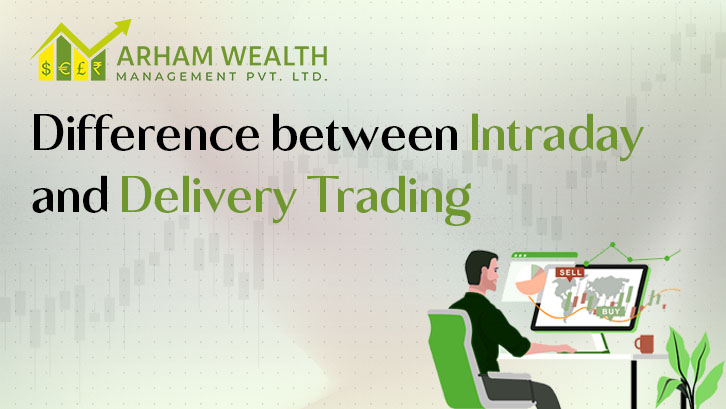


The stock market offers diverse opportunities to investors and traders, each with varying levels of risk, time commitment, and return potential. Two of the most common approaches in the equity markets are delivery trading and intraday trading. These trading styles differ fundamentally in terms of investment horizon, risk profile, capital requirement, and strategy.
Whether you're a seasoned trader or someone just beginning their journey in the stock market, understanding the differences between delivery and intraday trading is crucial. This blog dives deep into both methods, comparing their features, pros, cons, and most importantly—helping you decide which one aligns with your financial goals and risk tolerance.
Delivery trading involves buying stocks and holding them in your demat account for more than a single day, typically for weeks, months, or even years. You become the actual owner of the shares, giving you the right to earn dividends and benefit from long-term price appreciation. There's no obligation to sell on the same day, making it ideal for long-term investors. Delivery trading is generally considered safer than intraday trading and suits those who prefer a passive approach to investing and wealth creation over time.
Intraday trading means buying and selling stocks within the same trading day, without taking delivery. All positions are closed before the market closes. Traders aim to profit from small price movements using real-time data, technical charts, and quick decisions. This style of trading is fast-paced, high-risk, and requires constant monitoring of the market. It often involves leverage, which can amplify both gains and losses. Intraday trading is best suited for experienced traders who can handle market volatility and react swiftly to price changes.
| Delivery Trading | Intraday Trading | ||
| Pros | Cons | Pros | Cons |
| Wealth Creation: Ideal for building long-term wealth through compounding. | High Capital Requirement: You need full capital to buy shares. | Quick Profits: High return potential in a short time. | High Risk: One bad trade can wipe out profits. |
| Less Stressful: No need to watch the screen all day. | Slow Returns: Not ideal for those seeking quick profits. | Lower Capital: Margin trading allows greater exposure. | Stressful: Requires focus, discipline, and technical expertise. |
| Dividends & Rights: Eligible for dividends, bonus shares, and voting rights. | Market Risk: Stocks can depreciate over time. | Market Neutrality: Profit possible in both rising and falling markets. | No Asset Ownership: You don’t hold the stock; no long-term benefit. |
| Tax Efficiency: Long-term capital gains (LTCG) tax benefits. | No Overnight Risk: Positions are closed daily. | Brokerage & Charges: High trading frequency can rack up fees. | |
Read More: 10 Things to Know Before Opening Demat Account
Let’s assume two friends, Raj and Simran, both invest ?1,00,000 in the stock market.
Raj chooses delivery trading:
He buys shares of a fundamentally strong IT company. After 1 year, the stock appreciates by 25%, giving him ?1,25,000. Additionally, he earns ?2,000 in dividends.
Simran chooses intraday trading:
She trades daily using the same capital with a target of making 1% daily. Some days she gains, some days she loses. Over the year, due to brokerage, taxes, and a few big losses, she ends up with ?90,000.
This doesn’t mean delivery is better than intraday—just that consistent intraday success requires much more skill and discipline.
Understanding trader psychology is essential for success in both delivery and intraday trading. Each style demands a different mindset.
Delivery Trading Mindset
Delivery traders often need patience, discipline, and emotional detachment. Long-term investors must be willing to ride out market volatility without panic. Often, the biggest mistake in delivery trading is reacting emotionally to short-term news or fluctuations.
Investors also need to stick to their conviction and not be swayed by daily market noise. Many successful delivery traders rely on a long-term view, believing in the fundamentals of a company even when short-term sentiment is negative.
Intraday Trading Mindset
Intraday trading requires a high degree of focus, confidence, and speedy decision-making. Day traders operate in a fast-moving environment where hesitation can lead to missed opportunities—or bigger losses.
Intraday traders must learn to cut losses quickly and avoid revenge trading. Managing emotions like fear, greed, and overconfidence is a constant challenge. Without the right mindset, even the best strategy can fail.
Both trading styles rely on different types of analysis for making decisions.
Delivery Trading – Focus on Fundamentals
Delivery traders typically use fundamental analysis. This includes:
The goal is to identify undervalued companies with strong growth potential and hold them for the long haul.
Intraday Trading – Focus on Technicals
Intraday traders depend heavily on technical analysis, using charts and indicators to forecast short-term price movements. Common tools include:
News, economic data releases, and even global events can also affect intraday decisions.
Here are some frequent errors that investors and traders make:
In Delivery Trading:
In Intraday Trading:
Avoiding these pitfalls requires awareness, education, and practice.
There’s no one-size-fits-all answer. The decision between delivery and intraday trading depends on your:
If you’re just starting, delivery trading is generally safer and more forgiving. It allows you to learn about the market without the stress of minute-by-minute decisions. Once you gain confidence, you can explore intraday trading on a small scale.
Alternatively, many investors use a hybrid approach: investing long-term in fundamentally strong companies while allocating a small portion of their portfolio for short-term trades.
Both delivery and intraday trading offer distinct opportunities and challenges. Delivery trading promotes long-term wealth accumulation, while intraday trading offers a chance for quick profits at higher risks.
Your choice should reflect your financial goals, personality, and lifestyle. If you value stability and compound growth, go with delivery. If you thrive on real-time action and calculated risk, intraday could be your calling.
Either way, education, discipline, and a solid strategy are your most valuable tools in navigating the stock market.
Ready to start your trading journey? Open your demat and trading account today with Arham Wealth — your trusted partner in financial growth. Whether you're a long-term investor or an active trader, we’ve got the tools, insights, and support to help you succeed.